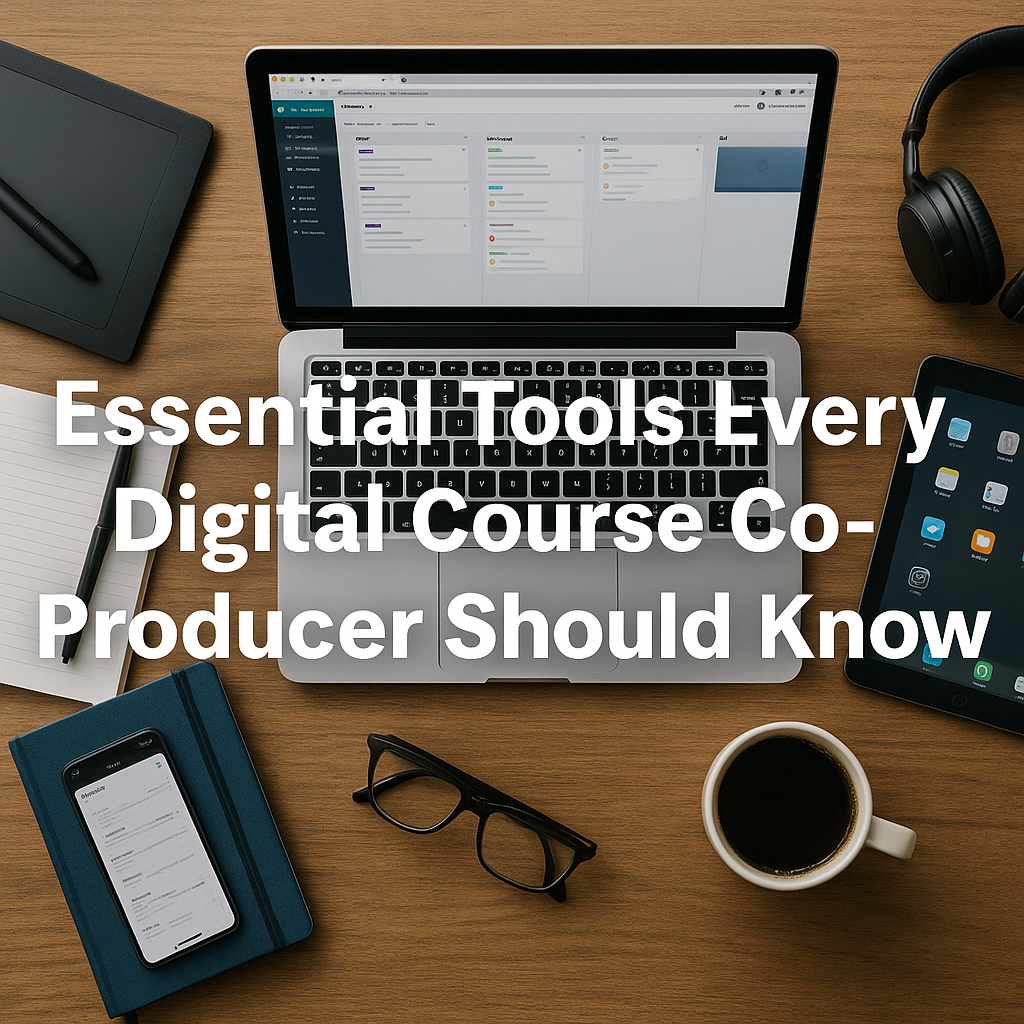When you’re working behind the scenes to bring a digital course to life, having the right tools makes all the difference. Whether you’re managing a team, setting up email automation, building sales pages, or organizing content production — your toolbox is the backbone of your efficiency and professionalism.
In this article, we’ll go over the essential tools that every co-producer should be familiar with. You don’t need to use all of them at once — but knowing what they do and when to use them will put you ahead of the game.
Why the Right Tools Matter
Many new co-producers start with just a notepad and a few emails. That might be enough for a micro-launch, but as you scale, you’ll need organization, automation, and clarity.
The right tools help you:
- Save time
- Avoid miscommunication
- Reduce errors
- Deliver a professional experience to both your expert and students
Let’s dive into the categories that matter most.
1. Project and Task Management
As a co-producer, you’ll juggle multiple tasks: scripts, design, ads, emails, deadlines. You need a central place to track everything.
Top Tools:
🔹 Trello – Kanban board for managing tasks visually
🔹 Notion – Highly customizable workspace for notes, tasks, calendars
🔹 Asana – Powerful for larger teams and workflows
🔹 ClickUp – Combines tasks, docs, goals, and time tracking
✅ Use these tools to plan your launch timeline, assign responsibilities, and track progress.
2. Communication and Collaboration
Efficient communication = smoother co-productions. You’ll be coordinating with the expert, designers, editors, and possibly affiliates.
Top Tools:
🔹 Slack – Real-time messaging, ideal for teams
🔹 Zoom – For meetings, recording interviews, and webinars
🔹 Google Meet – Great for quick calls and easily accessible
🔹 Loom – Record screen and video messages to explain tasks or feedback
✅ Use Loom to send feedback on landing pages or scripts without needing live meetings.
3. Course Hosting Platforms
This is where the course actually lives and where students get access. You want something easy to use, stable, and preferably integrated with payment systems.
Popular Platforms:
🔹 Hotmart – Very popular in Latin America; ideal for launches
🔹 Teachable – Great for solo creators and simple courses
🔹 Thinkific – Flexible and intuitive
🔹 Kajabi – All-in-one platform with CRM and email marketing
🔹 Gumroad – Simple option for selling digital products
✅ Consider the language, pricing structure, and customization options when choosing.
4. Funnel Building and Landing Pages
You’ll need to build landing pages for leads, thank-you pages, sales pages, and sometimes checkout pages.
Tools for Building Funnels:
🔹 ConvertKit – Email + landing pages
🔹 Leadpages – Simple and fast page creation
🔹 ClickFunnels – Complete funnel builder, best for high-converting pages
🔹 Elementor (WordPress) – Page builder for those using WordPress
✅ Good landing pages can make or break your launch. Copy, layout, and speed matter.
5. Email Marketing Automation
Email is one of the highest-converting sales channels in digital courses. As a co-producer, you’ll need tools to capture leads, nurture them, and drive conversions.
Best Email Tools:
🔹 MailerLite – Great for beginners, easy to use
🔹 ConvertKit – Excellent for creators and segmenting audiences
🔹 ActiveCampaign – Powerful automation and analytics
🔹 GetResponse – Includes email, landing pages, webinars
✅ Plan automated email sequences: welcome, pre-launch, cart open, cart closing, and follow-ups.
6. Graphic Design and Visual Content
Your course needs high-quality visuals for trust and appeal: thumbnails, banners, ad creatives, social media posts, etc.
Design Tools:
🔹 Canva – Easy to use, template-based design tool
🔹 Figma – Advanced design collaboration (ideal for teams)
🔹 Photoshop – For professionals who need precision
🔹 Crello – Alternative to Canva with great templates
✅ You don’t need to be a designer, but you must understand basic visual branding.
7. Payment and Sales Tracking
Ensuring the payment system works smoothly and you can track income is vital for both trust and decision-making.
Tools for Payment:
🔹 Hotmart, Eduzz, Monetizze – Payment + course hosting (mainly used in Brazil)
🔹 Stripe – For global credit card processing
🔹 PayPal – Widely accepted and easy to use
🔹 ThriveCart – Checkout system + affiliate management
✅ Choose based on your audience location and currency needs.
8. Analytics and Feedback
Knowing what works (and what doesn’t) helps you optimize future launches.
Key Tools:
🔹 Google Analytics – Track traffic, bounce rate, conversions
🔹 Hotjar – Heatmaps and visitor behavior
🔹 Facebook Pixel – For tracking ads and audience insights
🔹 Typeform / Google Forms – For collecting student feedback
✅ Use feedback loops to improve course content, UI, and the sales journey.
Bonus: Tools for Recording and Editing
If the expert is recording the content, you should guide them on the best tools for quality production.
Suggestions:
🔹 OBS Studio – Free tool for screen + webcam recording
🔹 Camtasia – For simple video editing
🔹 Descript – Transcribe and edit video/audio like text
🔹 Zoom – For interviews, classes, and masterclasses
✅ Audio and visual clarity help maintain student engagement.
Final Tips: Start Simple, Grow with Experience
You don’t need to use all these tools at once. Here’s how to choose wisely:
- Start with tools that help you launch your first product.
- As revenue increases, reinvest in upgrading your stack.
- Prioritize ease of use and integration across platforms.
Choose tools that fit your team size and project complexity.

